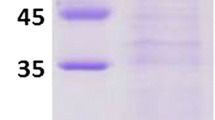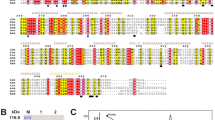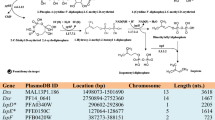Abstract
One of the most important step in structure-based drug design studies is obtaining the protein in active form after cloning the target gene. In one of our previous study, it was determined that an internal Shine-Dalgarno-like sequence present just before the third methionine at N-terminus of wild type lactate dehydrogenase enzyme of Plasmodium falciparum prevent the translation of full length protein. Inspection of the same region in P. vivax LDH, which was overproduced as an active enzyme, indicated that the codon preference in the same region was slightly different than the codon preference of wild type PfLDH. In this study, 5′-GGAGGC-3′ sequence of P. vivax that codes for two glycine residues just before the third methionine was exchanged to 5′-GGAGGA-3′, by mimicking P. falciparum LDH, to prove the possible effects of having an internal SD-like sequence when expressing an eukaryotic protein in a prokaryotic system. Exchange was made by site-directed mutagenesis. Results indicated that having two glycine residues with an internal SD-like sequence (GGAGGA) just before the third methionine abolishes the enzyme activity due to the preference of the prokaryotic system used for the expression. This study emphasizes the awareness of use of a prokaryotic system to overproduce an eukaryotic protein.



Similar content being viewed by others
References
World Health Organization (WHO). (2008). World malaria report 2008. Switzerland: WHO Press.
Baird, J. K. (2004). Chloroquine resistance in Plasmodium vivax. Antimicrobial Agents and Chemotherapy, 48, 4075–4083.
Patel, A. P., Staines, H. M., & Krishna, S. (2008). New antimalarial targets: The example of glucose transport. Travel Medicine and Infectious Disease, 6, 58–66.
Royer, R. E., Deck, L. M., Campos, N. M., Hunsaker, L. A., David, L., & Jagt, V. (1986). Biologically active derivatives of gossypol: Synthesis and antimalarial activities of peri-acylated gossylic nitriles. Journal of Medicinal Chemistry, 29, 1799–1801.
Azevedo, W. F., & Soares, M. B. P. (2009). Selection of targets for drug development against protozoan parasites. Current Drug Targets, 10, 193–201.
Dunn, C. R., Banfield, M. J., Barker, J. J., Higham, C. W., Moreton, K. M., Turgut-Balik, D., et al. (1996). The structure of lactate dehydrogenase from plasmodium falciparum reveals a new target for anti-malarial design. Nature Structural & Biology, 11, 912–915.
Turgut-Balik, D., & Holbrook, J. J. (2001). Determination of the DNA and amino acid sequences of the lactate dehydrogenase gene from Plasmodium falciparum, strains K1 and PF FCBR: A route to the design of new antimalarials. Turkish Journal of Biology, 25, 241–250.
Turgut-Balik, D., Shoemark, D. K., Sessions, R. B., Moreton, K. M., & Holbrook, J. J. (2001). Mutagenic exploration of the active site of lactate dehydrogenase from Plasmodium falciparum. Biotechnology Letters, 23, 923–927.
Turgut-Balik, D., Shoemark, D. K., Moreton, K. M., Sessions, R. B., & Holbrook, J. J. (2001). Over-production of lactate dehydrogenase from Plasmodium falciparum opens route to new antimalarials. Biotechnology Letters, 23, 917–921.
Gardner, M. J., Hall, N., Fung, E., White, O., Berriman, M., Hyman, R. W., et al. (2002). Genome sequence of the human malaria parasite Plasmodium falciparum. Nature, 419(6906), 498–511.
Berriman, M., Ghedin, E., Hertz-Fowler, C., Blandin, G., Renauld, H., Bartholomeu, D. C., et al. (2005). The genome of the African trypanosome Trypanosoma brucei. Science, 309, 416–422.
Ivens, A. C., Peacock, C. S., Worthey, E. A., Murphy, L., Aggarwa, l. G., Berriman, M., et al. (2005). The genome of the kinetoplastid parasite, Leishmania major. Science, 309, 436–442.
Fernandez-Robledo, J. A., & Vasta, G. R. (2010). Production of recombinant proteins from protozoan parasites. Trends in Parasitology, 26(5), 244–254.
Mehlin, C., Boni, E., Buckner, F. S., Engel, L., Feist, T., Gelb, M. H., et al. (2006). Heterologous expression of proteins from Plasmodium falciparum: Results from 1000 genes. Molecular and Biochemical Parasitology, 148, 144–160.
Vedadi, M., Lew, J., Artz, J., Amani, M., Zhao, Y., Dong, A., et al. (2007). Genome-scale protein expression and structural biology of Plasmodium falciparum and related Apicomplexan organisms. Molecular and Biochemical Parasitology, 151(1), 100–110.
Cregg, J. M., Cereghino, J. L., Shi, J., & Higgins, D. R. (2002). Recombinant protein expression in Pichia pastoris. Molecular Biotechnology, 16, 23–52.
Mattanovich, D., Branduardi, P., Dato, L., Gasser, B., Sauer, M., & Porro, D. (2012). Recombinant protein production in yeasts. Methods in Molecular Biology, 824(4), 329–358.
Sahdev, S., Khattar, S. K., & Saini, K. S. (2008). Production of active eukaryotic proteins through bacterial expression systems: A review of the existing biotechnology strategies. Molecular and Cellular Biochemistry, 307, 249–264.
Makino, T., Skretas, G., & Georgiou, G. (2011). Strain engineering for improved expression of recombinant proteins in bacteria. Microbial Cell Factories, 10, 32.
Shine, J., & Dalgarno, L. (1974). The 3′-terminal sequence of Escherichia coli 16S ribosomal RNA: Complementarity to nonsense triplets and ribosome binding sites. Proceedings of the National academy of Sciences of the United States of America, 71(4), 1342–1346.
Ma, J., Campbell, A., & Karlin, S. (2002). Correlations between Shine-Dalgarno sequences and gene features such as predicted expression levels and operon structures. Journal of Bacteriology, 184(20), 5733–5745.
Chang, B., Halgamuge, S., & Tang, S. (2006). Analysis of SD sequences in completed microbial genomes: Non- SD-led genes are as common as SD-led genes. Gene, 373, 90–99.
Schurr, T., Nadir, E., & Margalit, H. (1993). Identification and characterization of E. coli ribosomal binding sites by free energy computation. Nucleic Acids Research, 21, 4019–4023.
Weiss, R. B., Dunn, D. M., Dahlberg, A. E., Atkins, J. F., & Gesteland, R. F. (1988). Reading frame switch caused by base-pair formation between the 3′ end of 16S rRNA and the mRNA during elongation of protein synthesis in Escherichia coli. The EMBO Journal, 7(5), 1503–1507.
Wen, J., Lancaster, L., Hodges, C., Zeri, A., Yoshimura, S. H., Noller, H. F., et al. (2008). Following translation by single ribosomes one codon at a time. Nature, 452, 389–409.
Larsen, B., Wills, N. M., Gesteland, R. F., & Atkins, J. F. (1994). rRNA-mRNA base pairing stimulates a programmed-1 ribosomal frameshift. Journal of Bacteriology, 176(22), 6842–6851.
Li, G., Oh, E., & Weissman, J. S. (2012). The anti-Shine-Dalgarno sequence drives translational pausing and codon choice in bacteria. Nature, 484(7395), 538–541.
Pannola, L. (2010). A plausible role for the presence of internal Shine-Dalgarno sites. Bioinformatics and Biology Insights, 4, 55–60.
Bzik, D. L., Fox, B. A., & Gonyer, K. (1993). Expression of Plasmodium falciparum lactate dehydrogenase in Escherichia coli. Molecular and Biochemical Parasitology, 59, 155–166.
Turgut-Balik, D., Akbulut, E., Shoemark, D. K., Celik, V., Moreton, K. M., Sessions, R. B., et al. (2004). Cloning, sequence and expression of the lactate dehydrogenase gene from the human malaria parasite, Plasmodium vivax. Biotechnology Letters, 26, 1051–1055.
Sambrook, J., & Russell, D. W. (2001). Molecular cloning: A laboratory manual I–II–III (3rd ed.). New York: CSHL Press.
Laemmli, U. K. (1970). Cleavage of structural proteins during the assembly of the head of bacteriophage T4. Nature, 227, 680–685.
Brown, W. M., Yowell, C. A., Hoard, A., Vander Jagt, T. A., Hunsaker, L. A., Deck, L. M., et al. (2004). Comparative structural analysis and kinetic properties of lactate dehydrogenases from the four species of human malarial parasites. Biochemistry, 43(20), 6219–6229.
Winter, V. J., Cameron, A., Tranter, R., Sessions, R. B., & Brady, R. L. (2003). Crystal structure of Plasmodium berghei lactate dehydrogenase indicates the unique structural differences of these enzymes are shared across the Plasmodium genus. Molecular and Biochemical Parasitology, 131(1), 1–10.
Backendorf, C., Overbeek, G. P., van Boom, J. H., Van der Marel, G., Veeneman, G., & van Duin, J. (1980). Recognition of the 16S RNA in ribosome messenger recognition. European Journal of Biochemistry, 110, 599–604.
de Smit, M. H., & van Duin, J. (1990). Secondary structure of the ribosome binding site determines translational efficiency: a quantitative analysis. Proceedings of the National academy of Sciences of the United States of America, 87, 7668–7672.
Farwell, M. A., Roberts, M. W., & Rabinowitz, J. C. (1992). The effect of ribosomal protein S1 from Escherichia coli and Micrococcus luteus on protein synthesis in vitro by E. coli and Bacillus subtilis. Molecular Microbiology, 6, 3375–3383.
de Smit, M. H., & van Duin, J. (2003). Translational standby sites: How ribosomes may deal with the rapid folding kinetics of mRNA. Journal of Molecular Biology, 331, 737–743.
Priano, C., Arora, R., Jayant, L., & Mills, D. R. (1997). Translational activation in coliphage Qb: On a polycistronic messenger RNA, repression of one gene can activate translation of another. Journal of Molecular Biology, 271, 299–310.
Jayant, L., Priano, C., & Mills, D. R. (2010). In polycistronic Qb RNA, single-strandedness at one ribosome binding site directly affects translational initiations at a distal upstream cistron. Nucleic Acids Research, 38(20), 7199–7210.
Kim, J. H., & Pack, M. Y. (1993). Over-production of extracellular endoglucanase by genetically engineered Bacillus subtilis. Biotechnology Letters, 15, 133–138.
Author information
Authors and Affiliations
Corresponding author
Rights and permissions
About this article
Cite this article
Cicek, M., Mutlu, O., Erdemir, A. et al. Single Mutation in Shine-Dalgarno-Like Sequence Present in the Amino Terminal of Lactate Dehydrogenase of Plasmodium Effects the Production of an Eukaryotic Protein Expressed in a Prokaryotic System. Mol Biotechnol 54, 602–608 (2013). https://doi.org/10.1007/s12033-012-9602-z
Published:
Issue Date:
DOI: https://doi.org/10.1007/s12033-012-9602-z




